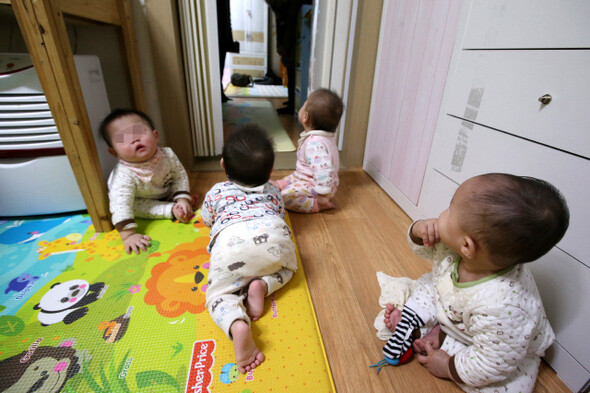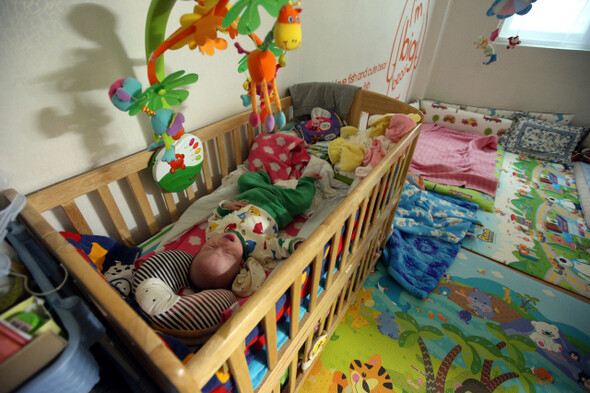hankyoreh
Links to other country sites 다른 나라 사이트 링크
[Reportage] With growing number of orphans, care center barely hangs on

By Kim Kyung-uk, staff reporter
The wind whipped through the foothills of Mt. Guryong, cutting like a knife. The chill penetrated the living room and corridors, where the heating didn’t reach. Parts of the ceiling were tattered and torn. Kangnam Children’s Home (http://www.kangnamhome.org), the center in Seoul’s Gaepo neighborhood where children go to live after being abandoned by their parents in the “baby box,” was a bleak place.
It was December 18, and “Hope” (not her real name) was fast asleep. She was four months old. Unlike the chilly living room, the room where she lay was heated. Her face was snowy white, and a faint scent of powdered milk filled the air. “It’s naptime,” the nursing assistants whispered. “She just had her formula and went down.”
Hope arrived at the home in October. She had been abandoned in the baby box at Jusarang Church in Seoul’s Nangok neighborhood, less than two weeks after she came into the world. All she had with her was a little note listing the date and time of her birth. Nameless, she was sent by the Gwanak District Office to the Seoul Metropolitan Childrens’s Welfare Center, then on to the Kangnam Children’s Home.
Sixteen infants like Hope live at the home, most of them abandoned like her. All of them come from different parents, but they share the surname “Kim” - their births were all registered in the name of the home’s previous director. Thirteen of them had been left in the baby box sometime in 2013. Of Seoul’s 26 childcare facilities, the home received the largest number of baby box infants last year.
The facility wasn’t originally a home for infants. Before, the center cared for children from as young as three to university age. It started in 1957 as the Siheung Nursery in Siheung, Gyeonggi Province, before moving to the foothills of Mt. Guryong in 1989. In 1990, it adopted its current status as a social welfare foundation named Kangnam Children’s Home. The current director is Hwang Yang-su, 56, who took over in 2003. It is a two-story building with 16 rooms, occupying 1,359 square meters of floor space on a plot of land measuring 3,062 square meters.
The home is supervised by Seoul Metropolitan Government. It began taking in infants back in July 2012. As more and more abandoned children from around the country were being found in Seoul, the city chose to address the shortage of care facilities by sending the babies to ordinary child care centers. Including Hope and fifteen other children under the age of two, Kangnam Children’s Home is the residence of 57 young people ranging from three years old to university age.
So far, the home has been making do without running water. The children here live on groundwater - boiling it to drink, heating it to wash. Purified groundwater is also used to make formula for the infants.
“We asked Gangnam District Office to hook up running water, but it was an expensive and complicated procedure, since there’s privately owned land mixed in with the road into the home,” explained Kim Hyun-sil, the home’s secretary-general. “So we’re using groundwater instead.”
Gangnam District Office said its hands were tied in terms of support. “Child care centers receive some of their funding from the central and local governments, but they’re basically private facilities,” explained Bae Kyung-suk, who heads the district’s child and adolescent team. “That means they have to pay for things like water hookups themselves. There are also limits to the district office’s ability to help.”
An official with the city’s Gangnam waterworks office said setting up running water would be a particularly expensive process. “A water hookup for a child care center would typically cost about 10 million won (US$9,460), but if there’s privately owned land mixed in there, it makes it difficult to install the pipes,” the official said.
“So it costs that much more to do the work.”
The cost is out of reach for the home, which is making do with little as it is.
The fact that the children there drink groundwater has put the home on the District Office’s list for “special management.”
“Running water is safe, whereas groundwater may be polluted,” explained an official with the district’s water control division on condition of anonymity. “The special management designation means we do water quality inspections every two years, along with frequent spot checks on the water quality.”
In addition to being old, the building is also underheated in the winter. Children there put on thick coats before leaving their rooms. Because of the prohibitive cost, the center heats only the rooms where the children live, while leaving the living room and hallways mostly unheated. The location in the foothills reduces the efficiency of any heat generated, resulting in large heating bills.
“Even heating just some of the rooms leaves us with a monthly bill of over four million won (US$3,800),” a nursing assistant.
It was only recently that private donations allowed the home to hook up a sprinkler system for fire prevention.
The only real support the home’s abandoned children get from the central government is a monthly living stipend of 180,000 won (US$170) each. It is not enough to live on. Indeed, it doesn’t even cover formula and diapers. Some of the infants around ten months of age - the ones born five to six months before Hope, who is the youngest right now - consume six cartons of formula a month, at around 25,000 won (US$23.70) each. A month’s worth of diapers costs 70,000 to 80,000 won (US$66-76). When the two are taken together, the bill is already over 200,000 won. And the many other infant essentials - weaning food, snacks, clothes, wet wipes, lotion, special baby-safe detergents - are well beyond what the state support might cover.
The home has to make do with private donations for the rest. Kim Hyun-sil explained, “We’re using private support to make up the shortage in food costs, snacks, and essentials, along with education and educational project costs. If it were just government support, we wouldn’t be able to operate.”
Making matters worse, donations have been dropping recently. A statement of the support received by the home showed donations reaching 193 million won (US$183,000) in 2011, before plunging to 78.8 million won (US$74,500) last year. In two years, it saw a 60% drop in support, which consisted mainly of donations of 5,000 to 10,000 won (roughly US$5-10) from citizens and contributions from companies and groups. Meanwhile, the number of abandoned children has risen, and the new under-two arrivals have strained the home’s budget needs. The contrast with the flood of donations to Jusarang Church’s baby box could not be starker.
The workers who care for the home’s children are even more on edge lately because of changes to the law. It’s difficult enough getting by on so little as it is, but amendments made to the enforcement decree and regulations of the Child Welfare Act in 2012 mean that it has to double the children’s living space by August 2015. The intentions of the amendment were good - giving the children a large and more stable living environment - but the policies fail to take into account the rising number of abandoned children.
Kangnam Children’s Home is already operating at capacity, having made room in its existing facilities to accommodate the abandoned infants. Children are living five or six to a room. It’s a group living arrangement, not a family-style “cottage system,” and the children are susceptible to illness. If one of them gets a cold, the others catch the bug eventually. Expanding the facilities would cost hundreds of thousands of dollars. Meanwhile, the central government maintains a hands-off approach, regarding child welfare facilities as a “local devolution program.”
“My worry is that a law intended for the children’s benefit will end up becoming an impediment to them,” Kim said. “The current framework is one where if we want to avoid breaking the law or meet its standards, we have no choice but the reduce the number of spots.”
Such a reduction would effectively be a death sentence for children with nowhere else to go. Nineteen months remain before the law goes into full effect. The children are growing up on a razor’s edge, facing the very real possibility of being cast out once again.

Hankyoreh and Childfund Korea’s campaign for abandoned children
The reader response to the Hankyoreh’s November piece on the baby box (“‘Baby box’ struggles with more abandoned newborns”http://english.hani.co.kr/arti/english_edition/e_national/613412.html) was overwhelming. As word spread about the systemic problems in a society where small children are being abandoned, many inquired about how they might be able to help.
A lot of people have made contributions to the baby box, but this alone is not enough to solve the abandonment problem.
The Hankyoreh is now partnering with the child welfare foundation Childfund Korea on a project to raise funds from our readers to help abandoned children. Our hope is that this campaign will offer a more effective way for citizens to share their concerns about child abandonment at a time when state support for these children is minimal.
Donations wired to Childfund Korea’s bank account (Kookmin Bank 6585901-1003818, registered as 어린이재단 [Childfund Korea, http://www.childfund.or.kr) will be used to cover living and medical expenses for abandoned children. For inquiries, please contact Childfund Korea at 1588-1940.
Please direct questions or comments to [english@hani.co.kr]

Editorial・opinion
![[Column] Season 2 of special prosecutor probe may be coming to Korea soon [Column] Season 2 of special prosecutor probe may be coming to Korea soon](https://flexible.img.hani.co.kr/flexible/normal/500/300/imgdb/original/2024/0426/3317141030699447.jpg) [Column] Season 2 of special prosecutor probe may be coming to Korea soon
[Column] Season 2 of special prosecutor probe may be coming to Korea soon![[Column] Park Geun-hye déjà vu in Yoon Suk-yeol [Column] Park Geun-hye déjà vu in Yoon Suk-yeol](https://flexible.img.hani.co.kr/flexible/normal/500/300/imgdb/original/2024/0424/651713945113788.jpg) [Column] Park Geun-hye déjà vu in Yoon Suk-yeol
[Column] Park Geun-hye déjà vu in Yoon Suk-yeol- [Editorial] New weight of N. Korea’s nuclear threats makes dialogue all the more urgent
- [Guest essay] The real reason Korea’s new right wants to dub Rhee a founding father
- [Column] ‘Choson’: Is it time we start referring to N. Korea in its own terms?
- [Editorial] Japan’s rewriting of history with Korea has gone too far
- [Column] The president’s questionable capacity for dialogue
- [Column] Are chaebol firms just pizza pies for families to divvy up as they please?
- [Column] Has Korea, too, crossed the Rubicon on China?
- [Correspondent’s column] In Japan’s alliance with US, echoes of its past alliances with UK
Most viewed articles
- 1[Column] Season 2 of special prosecutor probe may be coming to Korea soon
- 2‘We must say no’: Seoul defense chief on Korean, USFK involvement in hypothetical Taiwan crisis
- 3Division commander ordered troops to enter raging flood waters before Marine died, survivor says
- 4Is N. Korea threatening to test nukes in response to possible new US-led sanctions body?
- 5Is Japan about to snatch control of Line messenger from Korea’s Naver?
- 6No good, very bad game for Korea puts it out of Olympics for first time since 1988
- 7[Editorial] Korea’s surprise Q1 growth requires objective assessment, not blind fanfare
- 8Korea’s 1.3% growth in Q1 signals ‘textbook’ return to growth, says government
- 9N. Korean delegation’s trip to Iran shows how Pyongyang is leveraging ties with Moscow
- 10Amnesty notes ‘erosion’ of freedom of expression in Korea in annual human rights report